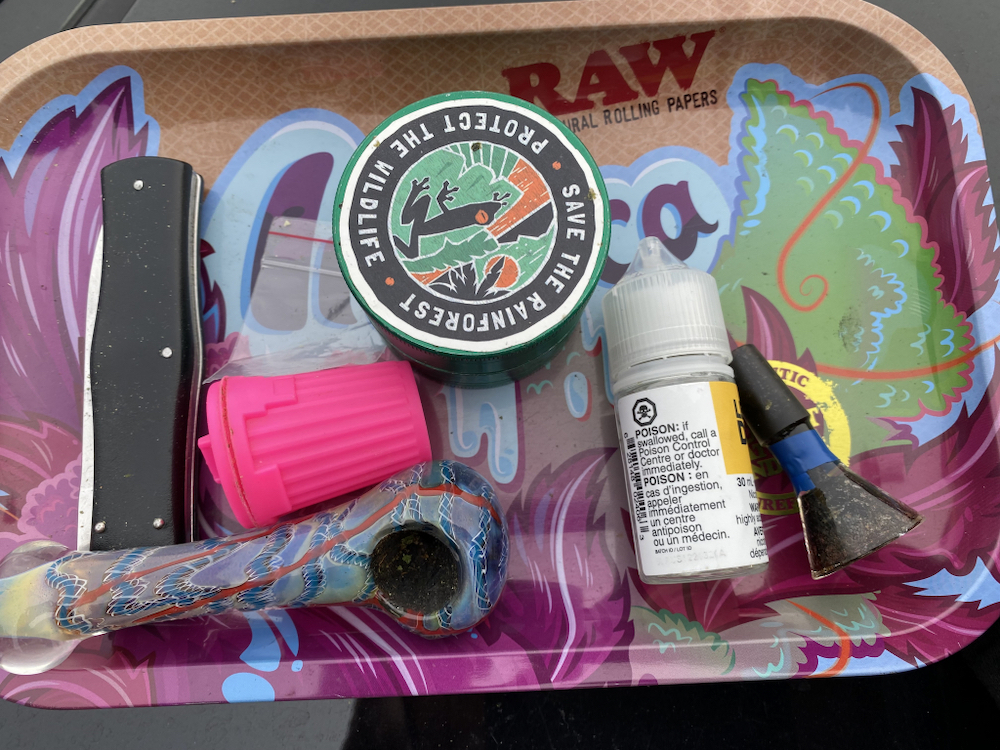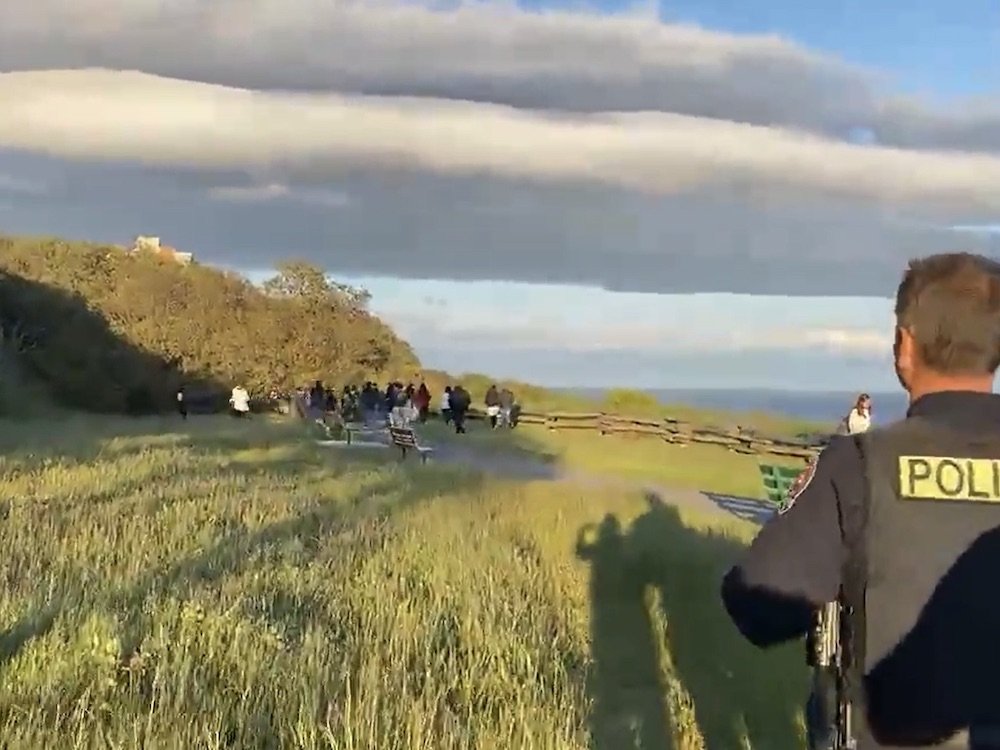In late May, the Victoria Police Department went viral.
The department posted a video to its Twitter account. Viewed more than 178,000 times, it shows a group of young people on Victoria’s Dallas Road waterfront path.
“Here's what it looks like as we approach a group of youths who are drinking,” reads the tweet.
There are about 30 young people in the video. Many run as a group of uniformed officers approach them.
The video is part of a string of tweets, news releases and public comments from the police department that critics say sends damaging messages about youth.
As teens emerged from pandemic restrictions and onto downtown streets this spring and summer, there have been reports of underage drinking, vandalism and violence.
But some residents and academics say depicting all of these instances together — and on such a public platform — is unfair.
“I worry about the criminalizing of youth and I worry about the resources and selection of cases that the police use in their public relations,” said Michelle Bonner, professor of political science at the University of Victoria.
“Not publicizing this issue would have allowed the teens involved to get the support they need without stigmatization.”
When asked about the decision to post the video, Bowen Osoko, a spokesperson for the VicPD, noted that it was shot from a distance in a public place as the police responded to a call.
Here's what it looks like as we approach a group of youths who are drinking. #VicPDLive #yyj pic.twitter.com/LZl1gVgOpY
— Victoria Police (@vicpdcanada) May 28, 2022
“It was important for people to know what we were seeing and what we were contending with. But also it's important for people not to jump to conclusions,” he said.
According to police, the video was part of a public awareness campaign — shared during a #VicPDLive "tweetalong" — launched in response to what they say was a spike in youth crime in downtown Victoria that started in early April.
Over a six-week period, police say they conducted 60 investigations and arrested 24 youths on charges that include public intoxication, possession of weapons, assault, assault with a weapon and mischief.

Whether offences committed by youth are actually increasing is difficult to determine. The Tyee requested statistics on youth crime over a 10-year period, but the VicPD declined multiple requests to provide the data prior to publication.
Perception of crime, however, is another matter — and a subjective one.
In May, the VicPD published four separate news releases about large groups of “swarming” youths in downtown Victoria who allegedly were drinking, engaging in drug use, vandalizing property and assaulting people. These news releases, which were reported widely by media, say that police were seeing large gatherings of about 150 youth — organized on social media — dispersed across the downtown core.
Police spokespeople told Victoria News they believed about 20 individuals, ranging in age between 14 and 21, were responsible for most of the violence and criminal behaviour.
After The Tyee reached out to the police department for an interview, it issued another news release stating there had been no reports of youth violence or vandalism over the past two weeks. The press release included photos of weapons and drugs confiscated from youth in prior weeks of enforcement, along with a list of violent incidents involving youth that had been outlined in the previous press releases.
Those incidents included a 70-year-old man being swarmed and seriously injured after being kicked, punched and spat on; a couple that was randomly attacked and a woman who was choked; an attack on an unhoused couple; and the swarming of a VicPD officer responding to reports of a "bear spray fight." Police say youth were also injured in these altercations.
Osoko said police decided to launch an awareness campaign due to the severity of the attacks and the number of youth police officers encountered who thought they would not face consequences because of their ages.
“We wanted these folks to know, ‘You can absolutely come downtown, you can enjoy yourself.... But know that if you're coming downtown to consume alcohol and you're underage, you're consuming drugs in violation of the Cannabis Act, you're bringing weapons, you're trying to do mischief, the police are going to be here and your Friday night is not going to be a very good time,'” Osoko said.
The VicPD live tweeted its enforcement efforts in downtown Victoria and the surrounding area on weekends — including posting photos of empty alcohol bottles, broken windows and ambulances arriving for intoxicated youth and stories of teens facing arrest.
“It's difficult for a family when a youth is too impaired and the family realize they cannot care for their loved one at home so they have to stay in cells,” one tweet reads.
Jaigris Hodson, Canada research chair in digital communication for the public interest and an associate professor at Royal Roads University, takes issue with the VicPD’s public relations team highlighting serious offences such as assault alongside underage drinking or public intoxication.
“By lumping these things together with limited context, it's kind of guilty by association in that then, the underage drinking looks like a bigger crime than it is,” said Hodson. “And that creates a false perception that there is more crime happening in Victoria than there is.”
The effect of this, she added, might be that residents support increases to policing budgets.
Osoko, when asked about the potential impact of increased public relations efforts, said that the VicPD board sets the department’s budget.
“The reality is, that's not a consideration for us,” Osoko said.
'People suddenly feeling unsafe’
According to several residents of James Bay and downtown Victoria, large gatherings of youth and underage drinking are common during this time of year.
Bharat Chandramouli, who lives downtown with his family, was familiar with the warm weather pilgrimage of youth into the city core before he started reading about it in police press releases. He believes Victoria’s heightened awareness — and fear — around crime is due to VicPD’s increased public relations efforts.
“There's just been so much more messaging on crime the last couple of years and it has coincided with people suddenly feeling unsafe,” he said, referencing a recent VicPD survey on the perception of safety in Victoria.
Of the 1,300 people who responded, 75 per cent said they felt safe downtown during the day and 29 per cent said they felt safe at night. According to the police, both numbers dropped over the past two years.
“Most people don't experience crime, they only see it through the media and police,” said Chandramouli. “So the more people report on it, the more people talk about it, the more people think there is a problem. And the more problems there are, the more pressure to spend money to solve problems.”
UVic professor Bonner said since the 1980s police across the country have worked to grow the public relations arms of their departments, culminating in active efforts by police departments' media teams to present the police in a positive light.
“The bigger issue that concerns me is, and this is not just in the case of the youth, but police use of public relations as a way to encourage the public to see [them] as the most appropriate response to social problems,” she said. “And particularly when we're talking about youth, there are other ways of addressing those issues than a policing response.”

Early on in the VicPD’s response to a rising number of calls about youth downtown, Osoko said the department did reach out to local school districts, neighbouring municipalities, regional police departments and the mobile youth service teams to discuss the best approach to the situation.
Jennifer Chambers, a counsellor in the Greater Victoria School District, took away two main points from participating in these meetings: there were large numbers of international students in different areas of downtown and some groups of students were becoming violent towards people and businesses.
“The numbers seemed greater — at least that’s what police were seeing — and the level of violence they were seeing within the group and towards other people was different and was unusual,” she said.
School district officials met with students and parents identified to them by the police and worked to help create a plan to “help these kids find different ways of connecting in a more positive way,” Chambers said.
However in May, students in the district’s international high school exchange programs received a letter from international education homestay manager Shandi Clague declaring a curfew effective May 14 that prevented students in the program from entering downtown, James Bay and the adjacent Beacon Hill Park after 5 p.m. on Fridays and Saturdays.
The curfew has since been rescinded. The school district refused to speak with The Tyee on the subject of this letter, or answer any questions about why or how long the curfew was in place.
Chambers said that although she is not part of the program that issued the curfew, the school district carries increased responsibility for international students.
“They have to take that more parental role, because those kids have come from other countries,” she said.
Isabela, a local exchange student from Brazil who asked that her last name not be used, waited more than a year to come to Victoria due to COVID-19 restrictions. When she received the school district letter, Isabela had just over a month left to explore the city she had come so far to see. She and her friends wanted to meet up downtown, grab a quick dinner at McDonald’s and hang out in Victoria’s many outdoor spaces. The curfew curtailed that.
“We got really mad, because we weren’t doing anything [wrong],” she said. “I know there are a lot of teenagers that are doing a lot of things, but they tried to blame the exchange students and we actually aren’t doing anything.”
After the 5 p.m. curfew for the international students was dropped, Isabela and her friends said, tensions have eased.
Chambers heard similar sentiments from other students. After years of isolation and losing activities such as sports due to the pandemic, students were excited to get back out with their peers.
Additionally, they expressed frustration with news reports “painting all teenagers, all having these struggles, are going downtown and getting into trouble, when really it was a small cohort,” Chambers said.
Digital communications expert Hodson said the ultimate issue is not whether youth were doing anything wrong. Rather, she believes that any group with significant power, such as the police, needs to weigh carefully the impact of filming people in vulnerable positions and posting the images to wide audiences on social media.
“If your PR involves filming people without their consent and posting it online, I think you are on the wrong side of this debate and you need to rethink that,” she said. “If you are a powerful group that has now taken the experience of this non-powerful group — in this case, teenagers — and you're using it for what looks like PR, you have some explaining to do there.”
Bonner argues that the public could benefit from public relations being taken out of policing altogether, with that responsibility put into the hands of the municipality or another elected group that has more direct accountability to the public. When police control their own communications, Bonner said, it gives them “an enormous amount of power” which has the potential to be misused.
Bonner fears the police publicity may lead the public to believe teen violence downtown is a pressing policy issue — one that must be solved with more policing.
“If it had to be publicized, there are other story frames that could be used such as one of collaboration between these partners noted, and attention could have been given to the steps taken by the school board and community organizations to address this issue,” she said, noting that actions taken by organizations outside the police were not included in the final press release.
“The story frame could be that there are some teens in Victoria who are struggling, this is resulting in problematic behaviour, but various community institutions and organizations are there to help them.” ![]()
Read more: Rights + Justice, Municipal Politics
















Tyee Commenting Guidelines
Comments that violate guidelines risk being deleted, and violations may result in a temporary or permanent user ban. Maintain the spirit of good conversation to stay in the discussion.
*Please note The Tyee is not a forum for spreading misinformation about COVID-19, denying its existence or minimizing its risk to public health.
Do:
Do not: